SQM 2006 June
2006-06-08
2:30 a.m. EDT
nearly overcast; garage lights (at lowered brightness) nearby
| Meter # | 730 | 731 | 732 | 733 | 734 | 735 | 736 | 737 | 738 | 739 | 740 | CB #131 | |
| 18.17 | 18.28 | 18.05 | 18.39 | 18.21 | 18.07 | 18.26 | 17.94 | 18.09 | 18.28 | 18.11 | 17.42 | ||
| 18.2 | 18.24 | 18.04 | 18.29 | 18.25 | 17.99 | 18.31 | 17.93 | 18.15 | 18.28 | 18.13 | 17.46 | ||
| 18.19 | 18.28 | 18.04 | 18.23 | 18.34 | 18 | 18.25 | 17.93 | 18.1 | 18.25 | 18.17 | 17.41 | ||
| Average | 18.19 | 18.27 | 18.04 | 18.3 | 18.27 | 18.02 | 18.27 | 17.93 | 18.11 | 18.27 | 18.14 | 17.43 | |
| Combined Average | 18.16 | ||||||||||||
From an astronomy software program I see the waxing gibbous moon is up at 19 degrees of altitude.
The Clear Sky Clock shows the sky is approaching total darkness:
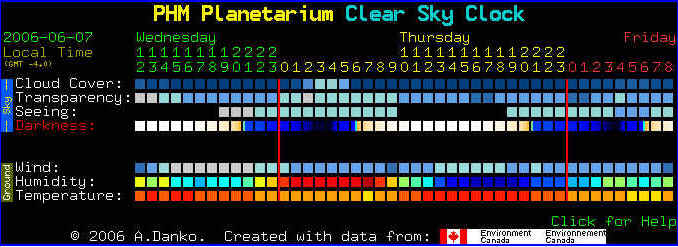
Turn off pop-up blocker (under Tools), click the Image Control box on far left, and put cursor over the Darkness block for that hour to see how long until darkness.
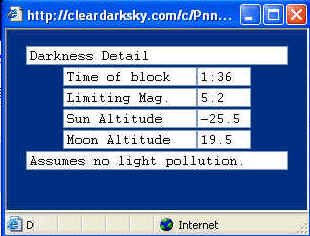
During this trial, the Clear Sky Clock just got updated! Two things happened...
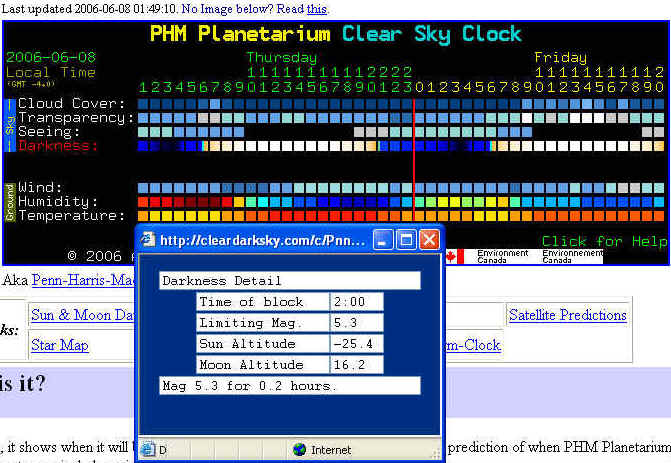
First, the days and their corresponding red line(s) shifted left. And second, I moved my cursor (not visible above) so that the "time of block" switched from 1:36 a.m. to 2:00 a.m.. By sliding the cursor across the Darkness blocks, I can see that from 3:12 a.m. until 4:12 a.m. the limiting magnitude will be about 6.0 or 6.1.
Meanwhile, from http://www.sunrisesunset.com/calendar.asp I can see the SQM measurements are after astronomical twilight on Wednesday night but before astronomical twilight on Tuesday morning::
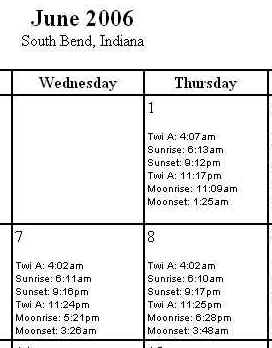
And the moon phase from http://www.nightwise.org/moonphase.htm:
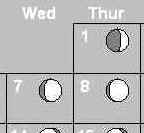
06-06-09
2006-06-09
12:30 a.m. EDT
clear, meter shaded from direct moonlight
one lamp post light is on
| Meter # | 730 | 731 | 732 | 733 | 734 | 735 | 736 | 737 | 738 | 739 | 740 | 131 | |
| 18.3 | 18.36 | 18.42 | 18.51 | 18.39 | 18.25 | 18.26 | 18.43 | 18.27 | 18.32 | 18.33 | 18.02 | ||
| 18.38 | 18.34 | 18.3 | 18.47 | 18.41 | 18.34 | 18.4 | 18.45 | 18.32 | 18.34 | 18.34 | 18 | ||
| 18.37 | 18.36 | 18.38 | 18.47 | 18.41 | 18.31 | 18.33 | 18.39 | 18.33 | 18.31 | 18.34 | 18 | ||
| 18.35 | 18.37 | 18.34 | 18.48 | 18.35 | 18.28 | 18.36 | 18.43 | 18.32 | 18.36 | 18.34 | 18 | ||
| Average | 18.35 | 18.36 | 18.36 | 18.48 | 18.39 | 18.3 | 18.34 | 18.43 | 18.31 | 18.33 | 18.34 | 18.01 | |
| Combined Average | 18.36 | ||||||||||||
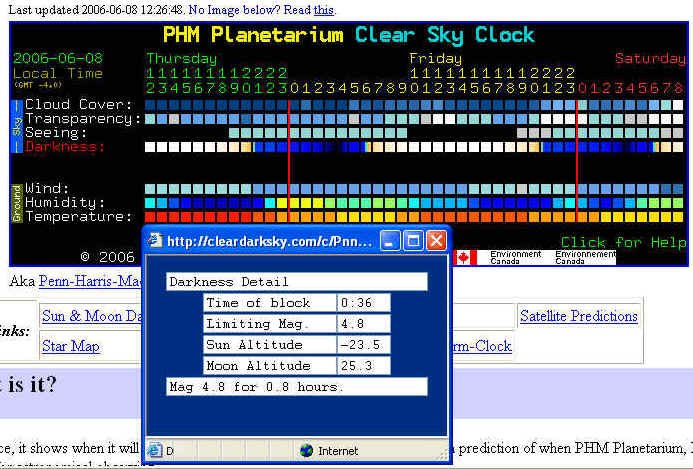
Note: per the CSC, a limiting magnitude greater than Mag 6 occurs from 3:36 until 4:12 a.m.:
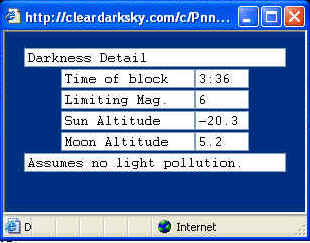
Clear Sky Clock data courtesy of A. Danko; used with permission.
From the PHM Clear Sky Clock at http://cleardarksky.com/c/PnnHrMPINkey.html:
It is based on Ben Sugarman's Limiting Magnitude calculations page. It takes into account the sun's and moon's position, moon phase, solar cycle and contains a scattering model of the atmosphere. It doesn't consider light pollution, dust, clouds, snow cover or the observer's visual acuity. So your actual limiting magnitude will often be different. |
A. Danko, creator of the Clear Sky Clock, writes:
"Accurate SQM readings should be had only when the clock's darkness line reads 6.0...The darkness line calculates a theoretical sky brightness that does not consider light pollution. But it does consider the phase of the moon, altitude of the moon and altitude of the sun...It clearly shows that even a gibbous moon can have very little effect when it is at only a few degrees altitude. The altitude at which a given phase of the moon affects the brightness at zenith varies in a complex way which the darkness model takes into account...While the 6.0 number the "darkness" line calculates for a sky free of scattered moonlight and sunlight is not quite right (mostly because vision varies hugely from person to person), it's a very good indication of when the sky will be at minimum brightness from light from the sun and moon." (Copyright ©2006 A. Danko; used with permission.)
